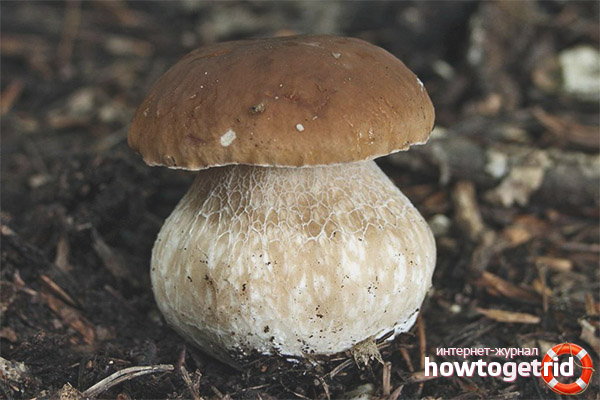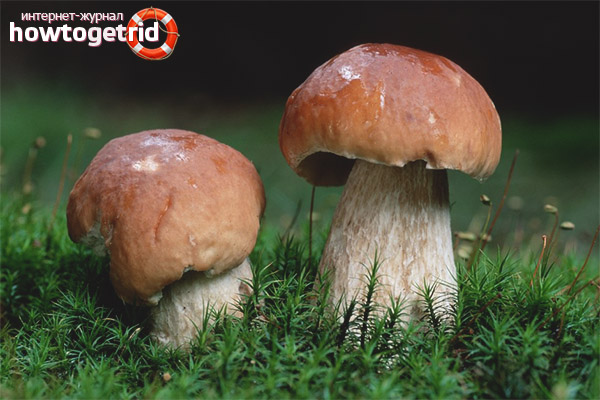The content of the article
Under the white mushroom refers to a variety of forest gifts, which are classified as a group of basidiomycetes. Also, these individuals have an order - flying, and a class - agaricomycetes. Representatives of the forest group from the genus Borovik have one common name - ceps. Some people prefer to call them old-fashioned mushrooms, but the essence remains the same. Among all the available variety of mushrooms, these are the most recognizable. People are happy to fill their baskets with them when they go on the so-called hunt.
Varieties
Before considering all the available species, we will examine for what reasons this gift of forest nature was so named. Already in ancient times, people appropriated the name to mushrooms, they did not bypass the family in question. Since man has long been engaged in the collection and processing of these specimens, the name came by itself. The flesh of a raw marbled mushroom remains white after drying or other processing. Partly for this reason, people called mushrooms white, despite the fact that they have a dark hat.
Now let's take a closer look at the available varieties.
- Reticulate. It belongs to the category permitted for consumption in food. According to its external data, it is similar to mushrooms, but the hat is pigmented with an ocher, brownish tint. Blotches of a reddish tone may be present. The hat is located on a shortened base. The leg itself is shaped like a cylinder. A mesh pattern is visible on it, which is pigmented brown or whitish. The diameter of the apex can reach 30 cm, but mushrooms with a hat of 6–20 cm are usually found. The soft part is ideally white. You can meet these mushrooms in the USA, Europe, Canada, Africa, Transcaucasia. Usually pick mushrooms go from June to September.
- Birch. He has another name - spikelet. The main characteristic is the presence of a whitish hat, which in diameter reaches 15 cm. The top may not be white, but cream or light with a yellow sheen. The base is shaped like a barrel, not a cylinder, like other members of the genus. It is light brown, with a white mesh at the top. If you cut off the mushroom, it will not turn blue. As for the pulp, it is white. As the name implies, the representatives of the group grow under birches. They have a fairly wide distribution area, found on the fringes, in various forest strips and birch groves. Fruiting begins in June and ends in October. Growth affects Western Europe, Russia.
- Pine. Another variety of porcini mushroom, which is characterized by a dark hat. It may have a purple hue. The hat varies in diameter from 6 to 28 cm. The soft part is covered with thin skin, it is red with a brown tint, and on the base is whitish. If you cut the leg, the flesh does not become bluish. The leg is compacted and extensive, brown or light (white), there is a red or brownish mesh on it. As the name implies, these members of the family grow in a pine forest. They love the sandy terrain, mountain peaks, deciduous forests. As for distribution, they are found in the vastness of our homeland, in the USA, Europe.
- Oak. The hat is brown in color, gray, not brown, predominates. On the surface, spots of whitish or ocher tones can be observed. The soft part is not very dense, loose than in all other varieties of this family of forest gifts. Mushrooms grow in the Primorsky Territory and the Caucasus. They are seen in the middle and southern strip of our homeland.
- Spruce. Perhaps the most common group.The base is elongated, compacted, with some thickening in the lower part. On the leg there is a mesh that extends 30 or 50% in length. The hat is brownish, chestnut or red shades prevail. These mushrooms are found in large quantities in the fir forest belt, as well as where there are many firs. They are found in Iceland, in the vastness of our country and in Europe. Fruiting continues until the fall.
- Dark bronze. Otherwise, the representatives of the group are called hornbeam or copper. Another edible variety of mushrooms, which is famous for its dark brown color. It is interesting that the legs with the hat can be the same in color. Often a mushroom looks black or so. In the lower part of the base there is a grid, which is first pigmented by a whitish, then becomes buffy. The leg is cylindrical in format. As for the pulp, it is brownish pink, bronze. If you make a cut, the shade will not change. The soft part is not loose, it smells pretty nice, the same in taste. These mushrooms are found in oak or beech forests. Harvest can be harvested in July, it will last until October. The gifts of nature are found throughout the territory of distribution in the United States of America and Europe.
Growth
- Porcini mushroom grows in different climatic regions, it can be found everywhere, with the exception of Antarctica or Australia. You can find these gifts in Europe, Mexico, Mongolia, Japan, and China. Fungi also grow in North Africa, North / South America. In the vastness of our homeland are found in Kamchatka, the Caucasus and the Far East. Naturally, it can not do without a presence in the southern and middle bands of Russia.
- As for the season of the year, in this matter it all depends on the territorial growth. As a rule, these fungi appear in late spring or early summer. Then, their collection can continue until the middle or end of the fall season (if the region is warm). If the growth is carried out in cold climatic regions, then the collection is best carried out in May-September. Most mushrooms are observed in August.
- If we consider the growth phase of the represented family, then the fungus will reach maturity in a full week. By the nature of growth, these are family fungi that live colonially. If a mushroom picker meets one mushroom, then in the neighborhood it will surely find many more gifts.
Description
- According to the length of the legs, the indicators vary within 12 cm. However, according to experience, mushroom pickers claim that they encountered mushrooms much higher (up to 25 cm). As for the diameter, the base is 7-9 cm. These mushrooms differ in the shape of the legs, namely, barrel-shaped or oval vertically. If the mushroom is old, its base will take on the shape of a cylinder. The color of the legs is brownish or white, may be with dark spots.
- Once the mushrooms are fully ripe, their flesh becomes quite dense. It has an attractive white color, meatiness and juiciness. You may notice that the older the specimen, the more the flesh acquires a fibrous structure. In addition, it begins to turn slightly yellow. Also, in old mushrooms, the flesh may have a light beige hue.
- It is worth noting a characteristic feature of all specimens that belong to the genus of boletus. Such mushrooms have a unique taste and delicate aroma. The hat of a mature mushroom has a brownish-brown color. In addition, it grows from 7 to 30 cm.
- However, in certain areas, under conditions of mild temperature conditions and frequent rains, it is often possible to find porcini mushrooms with a hat diameter of up to 50 cm. To determine the age of an instance, one does not need to have any special knowledge.
- Young mushrooms are distinguished by a convex cap of perfect shape. As for overripe specimens, it becomes flat.Often you can see that the hat even bends in the opposite direction. The surface of the mushroom is often quite pleasant to the touch.
- Hats have a velvety structure. The upper skin is quite difficult to separate, since it has a tight connection with the pulp. If the weather is quite windy or dry, the hat begins to become covered with deep cracks and wrinkles. As a result, the pores of the fungus are seriously damaged.
- As soon as rainy weather begins, on the surface of the cap of the mushroom you can see the shell in the form of mucus. Separately, it is worth mentioning that the color of the hat of the specimens in question can be varied. Shades begin from red-brown to almost white. Old mushrooms have a looser hat.
Benefit
- Considered mushrooms have a huge amount of minerals useful to humans. It is such instances that are considered one of the most useful and popular. It is worth noting that the pulp of porcini mushrooms contains the optimal amount of selenium.
- Such a substance contributes to the elimination of oncological pathologies in humans. Systematic eating of mushrooms allows you to fight quite serious diseases in the early stages. In addition, ascorbic acid and protein are present in the specimens. Together, enzymes improve the normal functioning of all internal organs.
- The aromatic and fleshy pulp contains a sufficient amount of calcium. In addition, the fungus includes iron and phytohormones. They are considered simply necessary for a person. Together, all enzymes can neutralize all inflammatory processes that occur in the body.
- Riboflavin is also present in the white specimen. It is such a substance that stabilizes the activity of the thyroid gland. In addition, the vitamin promotes better growth of nails and hair. As for a sufficient amount of B vitamins, they favorably affect the entire nervous system of a person.
- Such vitamins positively affect the work of the brain, memory, energy metabolism. B vitamins protect the mucous membranes and skin from all kinds of infections. In addition, enzymes directly affect the quality of sleep, appetite and good mood.
- Cep contains lecithin. Such a substance is especially necessary for those who suffer from anemia and atherosclerosis. Also, the enzyme qualitatively cleanses blood vessels from cholesterol. Among other things, such instances are very appreciated due to the presence of B-glucan in them.
- This substance is an antioxidant that strengthens the protective functions of the body. Such an enzyme perfectly resists various viruses, fungi and bacteria. In addition, ergotionin is found in the composition of the cep.
- The latter is responsible for the renewal and regeneration of cells throughout the body. The substance is of particular benefit to the eyes, kidneys, spinal cord and liver. In addition, due to the composition of the product in question, the secretion of digestive juice is well stimulated.
- Separately, it is worth mentioning that ceps belong to low-calorie foods. They consist of almost 90% water. For this reason, such instances can be dried, stewed, fried and pickled without any problems for the winter.
- When cooking, the pulp turns out to be unusually tasty and tender. In addition, the mushroom aroma will not leave you indifferent. It is especially enhanced after heat treatment. The greatest aroma comes from the cep, if properly dried. At this time, the flesh begins to gradually lose moisture.
Harm
- Despite the edibility of such specimens, they can still be poisoned. Do not forget that chitin is present in the mushrooms. It is he who is very difficult to absorb by the body of the child.
- You also need to be extremely careful for pregnant girls and individuals who suffer from diseases of the kidneys and digestive system.
Remember that over time, all fungi accumulate in their composition heavy toxic metals that are present in the earth. Therefore, in no case do not collect them in a non-ecological zone. Prefer exclusively wild forests and clearings. In this case, in the absence of contraindications, you will receive exceptional benefit from the presented product.
Video: white mushroom - how to quickly find in the forest












Submit